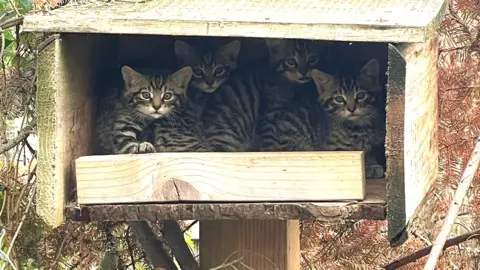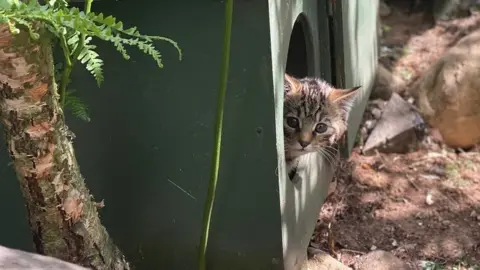Wildcat kittens bring hope for endangered species
 RZSS
RZSSHopes for the future of the Scottish wildcat are being placed in 11 bundles of fur born at a conservation centre this year.
The kittens were born in four litters at the Highland Wildlife Park in the Cairngorms National Park.
They are part of the conservation project by Saving Wildcats, which is trying to bring the species back from the "brink of extinction".
It is hoped the kittens could be released into the wild next year.
Wildcats Droma and Fruin gave birth to four kittens each, two kittens were born to Fian and one to Torr.
It is the second year in a row that wildcats have been born at the centre, with kittens born in 2022 becoming part of the first trial releases last month.
About 20 of the "Highland tigers", one of the UK's rarest species, could be released in the next two years from the "conservation breeding for release centre".
The Royal Zoological Society of Scotland (RZSS) is leading the project, working with national and international experts to increase Scotland's critically endangered wildcat population by breeding and releasing them into the Cairngorms Connect area of the Cairngorms National Park.
Work is also being done to try to mitigate the threats the animals face in the wild.
 RZSS
RZSSWith the Scottish wildcat on the facing extinction, David Barclay, conservation manager at the Saving Wildcats team, said the kittens would "play an important role in securing a future for the species".
Mr Barclay said: "We know there are 11 kittens from four litters so far and we hope there will be more born in coming weeks.
"It is still early days for our new wildcat kittens who are vulnerable in their first weeks and months.
"Over the next year, the wildcats will be prepared for the challenges of life in the wild. Once they are independent and no longer reliant on their mums, they will move into large pre-release enclosures designed to support natural development and reduce exposure to humans and disturbance."
He added: "Everything we learn from the wildcat releases which have begun this year will help to inform the future releases and ensure they are as successful as possible."
Earlier this year, a five-year project led by NatureScot concluded there were too few wildcats in the country for the population to be viable, with most cats living in the wild being hybrid breeds.
Measures recommended to save the species included releasing captive-bred wildcats in certain locations, alongside efforts to neuter hybrid and feral cats and improving habitats.
